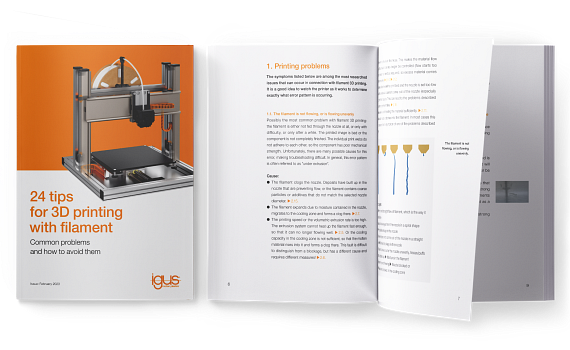The igus 3D Printing Academy for wear-resistant components
Find out here how to use additive manufacturing successfully with wear-resistant plastics to increase the service life of your applications and reduce production costs. On this page, our 3D printing experts share their expertise in design, material selection and manufacturing for industrial requirements.
On-demand webinars and live streams
Current dates for webinar live streams and recordings of past events.
Go to the videos
Design instructions and printing tips
Designing for industrial 3D printing: blog posts with tips and instructions from our experts.
To the articles
Free e-papers and downloads
Further content and detailed guides on industrial 3D printing in practice for download
To the downloads
On-demand webinars and live streams
print2mold: faster to series production thanks to injection moulding using 3D-printed metal tools
What are the advantages of injection moulding with additively manufactured tools and what should you bear in mind when designing the components? Dhruval Raval, Development Engineer for Rapid Tooling and Additive Manufacturing, and Tom Krause, Head of Additive Manufacturing, present the print2mold manufacturing method. It allows you to manufacture abrasion-resistant special parts and small series quickly and cost-effectively.Go to full-length recording
How does 3D printing with filaments succeed?
How do I select the right filament for my application and what do I have to consider before and during processing? Niklas Eutebach, Development Engineer at igus, shares his practical knowledge of 3D printing with filament and gives tips on material selection, processing and reworking.Which igus tribofilament is the right one for my application and my printer?
What is the best solution for my application – print 3D printing components myself or order them from the 3D printing service? Which tribofilament is the best one for my application? Development Engineer Niklas Eutebach presents the igus 3D printing materials.Three common mistakes when 3D printing gears
The 3D printing of gears allows for a fast production of individual gears for prototypes, replacement parts and small-series applications. However, to produce such an important machine part, factors like the right design, material and printing process must be considered. As mistakes often occur here, a lot of engineers still believe that 3D-printed plastic gears are not suitable for industrial applications. In this talk, Tom Krause will look into the most common errors in 3D printing of gears and show how to avoid them.Wear-resistant 3D-printed parts with food conformity, what is possible? Materials, methods, reworking
We can manufacture abrasion-resistant 3D-printed parts for food contact in our own printer or via our fast 3D printing service. The 3D printing materials made from iglidur are self-lubricating and food-safe according to the FDA and/or EU regulation 10/2011. If required, individual special parts, replacement parts and prototypes can even be manufactured overnight as a single piece or in series. In this presentation, Tom Krause will explain which plastics are used and how to get hold of special parts that conform to food standards as quickly as possible.Additive manufacturing in series: five application examples in line with "cost down, life up"
Where can 3D-printed components made from wear-resistant iglidur plastics be used? Tom Krause, Head of Additive Manufacturing at igus, will present five possible application areas in a live presentation. From components for a gas ring to special gliders in a sea mower - 3D-printed components from iglidur help reduce costs and increase service life in numerous applications, according to the igus principle "cost down, life up".Multi-material 3D printing for intelligent or extremely rigid components
Multi-material 3D printing enables, among other things, the production of structurally strong and rigid components with low-friction segments where they are needed. For this purpose, the fibre-reinforced filament igumid P150 is combined with the tribofilament iglidur i150 within one printing process. This is how, e.g. slide-optimised lightweight components are created. Furthermore, it is possible to combine wear-resistant plastics with conductive material and thus sensor technology. This results in the manufacturing of components that indicate overload or when the wear limit is reached, and can thus prevent machine failure. Niklas Eutebach, Development Engineer for Additive Manufacturing, presents the possibilities and methods of multi-material printing.3D printing of plastic gears: faster to series production thanks to online service life calculation
How can you calculate and optimise the service life of 3D-printed plastic gears? How can you reduce trial periods and testing times and reach volume application faster? Tom Krause, Head of Additive Manufacturing at igus, uses the igus gear service life calculator to show the quick and easy calculation, design and optimisation of durable plastic gears.
Go to the online workshop
Online seminar: why not print gears instead of machining them?
Due to the involute gearing, it is often difficult to design 3D-printed gears without assistance. However, not only the design, but also selecting the right material and the suitable manufacturing process are essential for developing a long-lasting gear. In this online seminar, Dipl. Ing. Tom Krause addresses these topics and shows possible solutions by using the igus gear CAD configurator and the 3D printing service.Go to the online seminar
Design instructions and printing tips from our blog
Free e-papers and downloads
Design guide
Download the design guide
Guidelines for 3D printing with filament

Download filament guidelines
Industry brochure

Download industry brochure
Guidelines for 3D printed gears
Download gear guidelines
Do you have questions, suggestions or would you like workshops and learning material about specific topics? Write to us.




